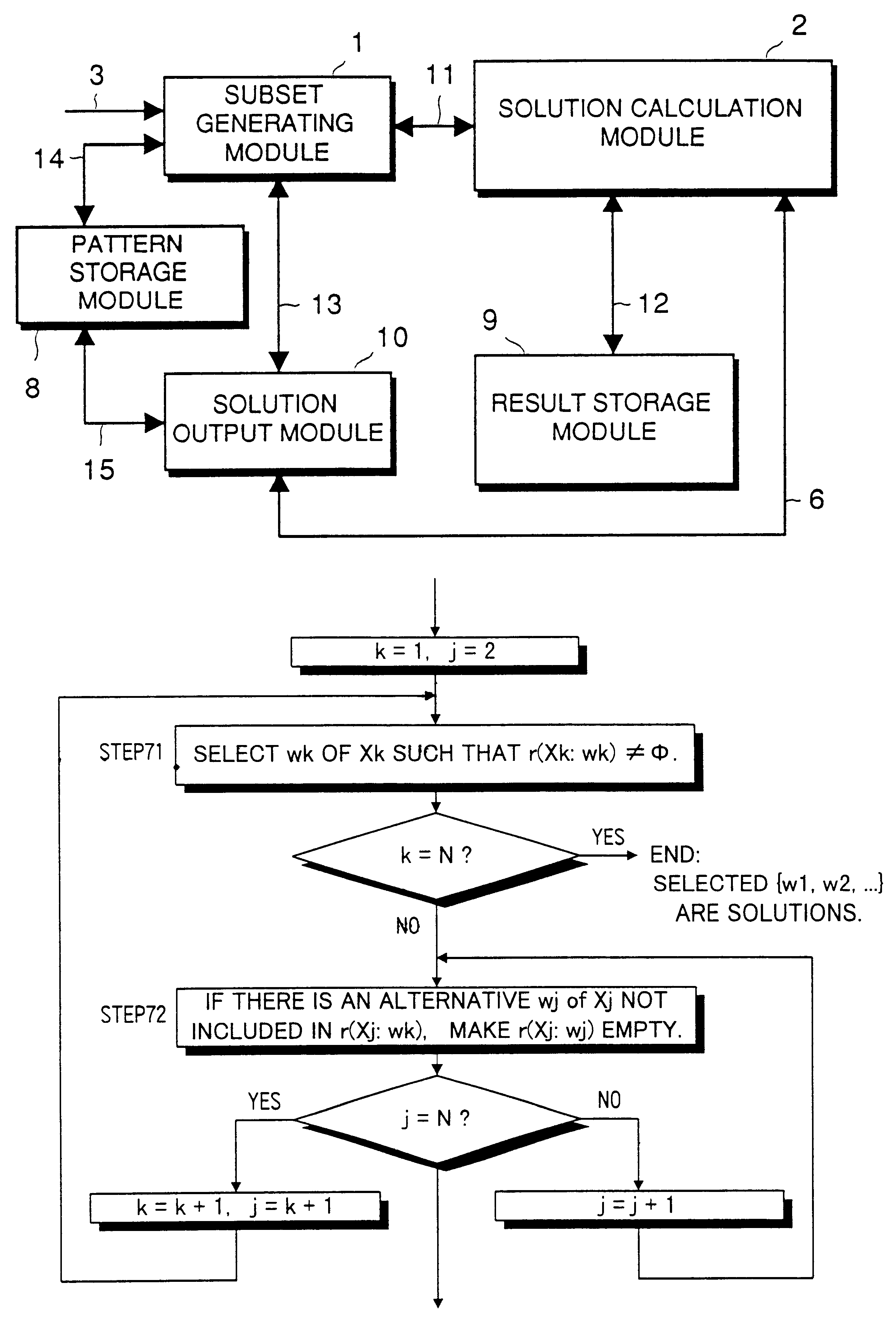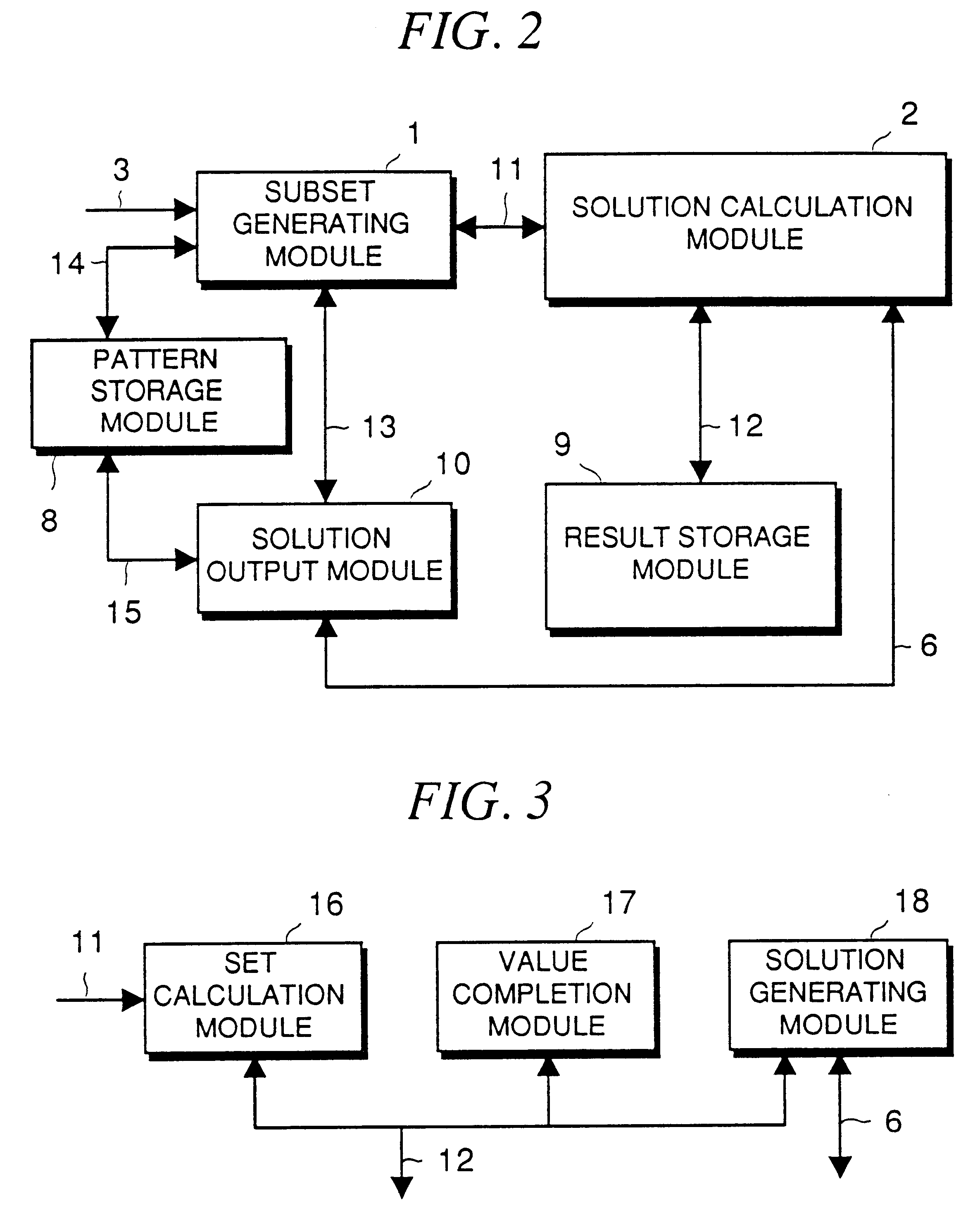System for solving of a constraint-satisfaction problem and constructing of a system
a system and problem solving technology, applied in the field of system for solving a problem of constraint-satisfaction and system construction, can solve the problems of difficult for a designer to make such a judgment, and the inability to design machine x, and achieve the effect of reducing increasing the difficulty of making such a judgmen
- Summary
- Abstract
- Description
- Claims
- Application Information
AI Technical Summary
Problems solved by technology
Method used
Image
Examples
example 1
(3) Example 1
The following explains how an exemplary problem are solved according to the above procedures. In this example, the problem includes parts A, B, C, and D, each part having six alternatives a1-a6, b1-b6, c1-c6, and d1-d6, as shown in FIG. 8. There are constraints between each two parts of four pairs, (A, B), (B, C), (C, D), (D, A). In FIG. 8, permissible combinations between each two parts of part pairs, except that between parts D and A, are connected by lines. In addition to combinations shown in this figure, alternative a1 may be combined with only d1 or d2, and alternative a4 may be combined with only d3.
That is, assume that parts of the problem and alternatives for the parts are as follows:
Part A: Alternatives a1, a2, a3, a4, a5, a6
Part B: Alternatives b1, b2, b3, b4, b5, b6
Part C: Alternatives c1, c2, c3, c4, c5, c6
Part D: Alternatives d1, d2, d3, d4, d5, d6
and that permissible combinations of alternatives are as follows:
Parts A and B: (a1:b1), (a3:b3), (a4:b6), (a5...
example 2
(4) Example 2
The following shows an exemplary problem in which, unless an alternative set is divided, a reachable value set does not become empty even if there is no solution.
(4-1) Processing by Subset Generating Module
Assume that parts of the problem and alternative for the parts are as follows:
Part A: Alternatives a1, a2, a3
Part B: Alternatives b1, b2, b3
Part C: Alternatives c1, c2, c3
Part D: Alternatives d1, d2, d3
and that permissible combinations of alternatives are as follows:
Parts A and B: (a1: b2 / b3), (a2: b1 / b3), (a3, b1 / b2)
Parts A and C: (a1: c2 / c3), (a2: c1 / c3), (a3, c1 / c2)
Parts A and D: (a1: d2 / d3), (a2: d1 / d3), (a3, d1 / d2)
Parts B and C: (b1: c2 / c3), (b2: c1 / c3), (b3, c1 / c2)
Parts B and D: (b1: d2 / d3), (b2: d1 / d3), (b3, d1 / d2)
Parts C and D: (c1: d2 / d3), (c2: d1 / d3), (c3, d1 / d2)
For this problem, the following data is entered into subset generating module 1 (see FIG. 25):
Part A, part B, part C, part D:
(a1, a2, a3), (b1, b2, b3), (c1, c2, c3), (d1, d2, d3):
(part A, part B)=(a...
PUM
 Login to View More
Login to View More Abstract
Description
Claims
Application Information
 Login to View More
Login to View More - R&D
- Intellectual Property
- Life Sciences
- Materials
- Tech Scout
- Unparalleled Data Quality
- Higher Quality Content
- 60% Fewer Hallucinations
Browse by: Latest US Patents, China's latest patents, Technical Efficacy Thesaurus, Application Domain, Technology Topic, Popular Technical Reports.
© 2025 PatSnap. All rights reserved.Legal|Privacy policy|Modern Slavery Act Transparency Statement|Sitemap|About US| Contact US: help@patsnap.com



